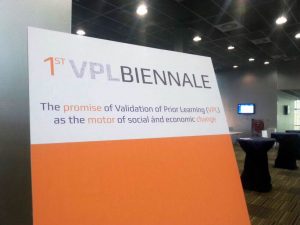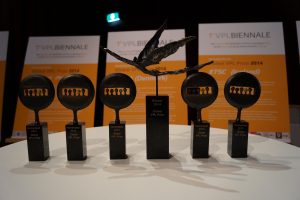More than 200 participants from different European countries, the Republic of Korea and Canada attended the 1st VPL Biennale in the Netherlands from 9 to 11 April 2014.
| Number | 1st |
| Year | 2014 |
| Theme | The promise of Validation of Prior Learning (VPL) as the motor of social and economic change |
| Location | Rotterdam, The Netherlands |
| Organiser | EC-VPL |
Mission

The mission of The 1st VPL Biennale was to share information, knowledge, ideas and visions on VPL ánd about the creative process of learning from each other’s successes, problems and solutions in ‘the VPL-world’. This entails a focus on the systematics of Validation of Prior Learning as the motor of more effective learning and working processes; all-inclusive for all citizens, regardless of status, gender, age, philosophy, special need, heritage or any other personal feature.
The central theme of the 1st VPL Biennale concentrated on ‘The promise of VPL as the motor of social ánd economic change‘. It was about sharing information, knowledge, ideas and visions on VPL ánd about the creative process of learning from each other’s successes, problems and solutions in ‘the VPL-world’. The event was to share how governments, employers, trade unions, social and volunteering organisations, schools, universities and other institutions are linking VPL to qualifications, further education and training, employability and personal development.
The crucial question for The 1st VPL Biennale in this respect was how to further develop and implement VPL as an effective method in lifelong learning perspectives, being able to integrate all citizens effectively and quality-assured into lifelong learning strategies at all levels and in all environments and contexts?

This question relates to priority areas in policy and practices, related to enhancing lifelong learning perspectives and to foster social and economic progress by:
- further developing and implementing existing national legislation on VPL-enhanced lifelong learning;
- moving on towards integrating VPL in all learning levels and environments;
- strengthening the levels of professionalism in VPL-functions to be able to cope with customer-steered and competence-based lifelong learning, like functions of guidance, individualised and flexible teaching/learning, managing flexibilised programmes;
- opening up learning opportunities for all citizens with a special focus on underrepresented groups and non-traditional learners.
Themes
The mission of the 1st VPL Biennale brought the following themes to the fore:
- The power of VPL: piloting VPL in structured environments can strengthen the impact in VPL and the dissemination to other contexts. Case studies, especially good practices offer a window to this promise. Or not? What are the critical success factors for implementing VPL?
- The roadmap of VPL: who developed a roadmap for integral implementation of VPL-systematics? What are the building blocks? Is it an integral approach with strongly interlinked steps in the process?
- Linkages of VPL: VPL matches many standards, from personal and group-standards to sector or national standards. Which linkages are the best to focus on: linkages aiming at personal enrichment, career-steps, certification or other?
- Personalization of learning as an outcome of VPL-processes: the portfolio is the life changer of individuals that can express personal learning needs and requirements. What are the pillars of this personalization: the portfolio, ownership of learning, learning independence, or other factors? Where do top-down strategies for VPL-systematics meet up with the bottom-up approach of portfolio-steered, personal development that is enhanced by VPL too?
- Quality-assurance of VPL: trust or control? The quality of VPL-systematics has to be safeguarded. It concerns the offer of reliable and understandable instruments ánd the availability of professionals to support and maintain these instruments (guiders, assessors, trainers, managers, etc.). But how to quality assure these instruments and professionals best?
- Open and flexible learning – supported by e-tools – is vital for making sure the impact of VPL in lifelong learning strategies lasts longer. But in whose interest and how to realize this? Are there successful examples? How to link e-tools such as e-portfolios to the learner’s motivation?
The keynotes and the parallel sessions pointed out that VPL already is active in all lifelong learning-perspectives (qualification-oriented, function-oriented and person-oriented) on the labour market and in education.
VPL needs to move from fragmentation to integration. In the coming years, VPL is explicitly going to be (further) embedded in the primary processes of learning (vocational, university) and working (HR systems, collective agreements, training funds). VPL will be – within these two main systems as well as between them – a matchmaker and ‘guide’ for sustainable personal development, shared ownership citizens-organisations of competency-based development and flexibility of the system.
The book ‘Linkages of VPL’ has been published is both a result of the project ALLinHE and the keynotes and parallel sessions, as well as an agenda for further exploring and paving the way for VPL, not only in higher education but also in other qualification-levels and – even better – in contexts of work, volunteering, citizenship, inclusion activities and leisure. With this book, the aim is to show that lifelong learning is possible in any context, country and culture, and that there are always shared elements that make it possible to make a manageable tool for lifelong learning out of the methodology of VPL.
